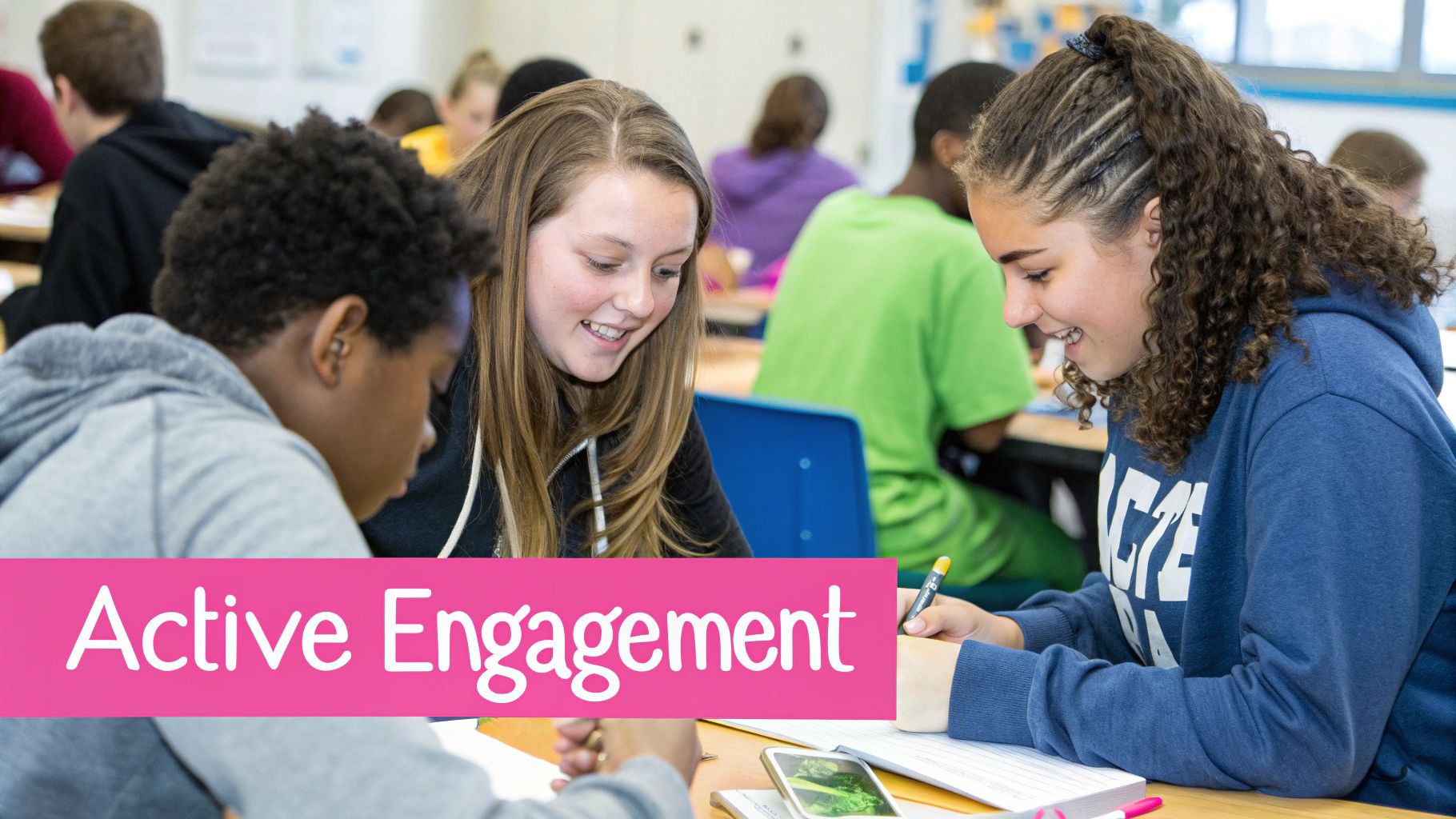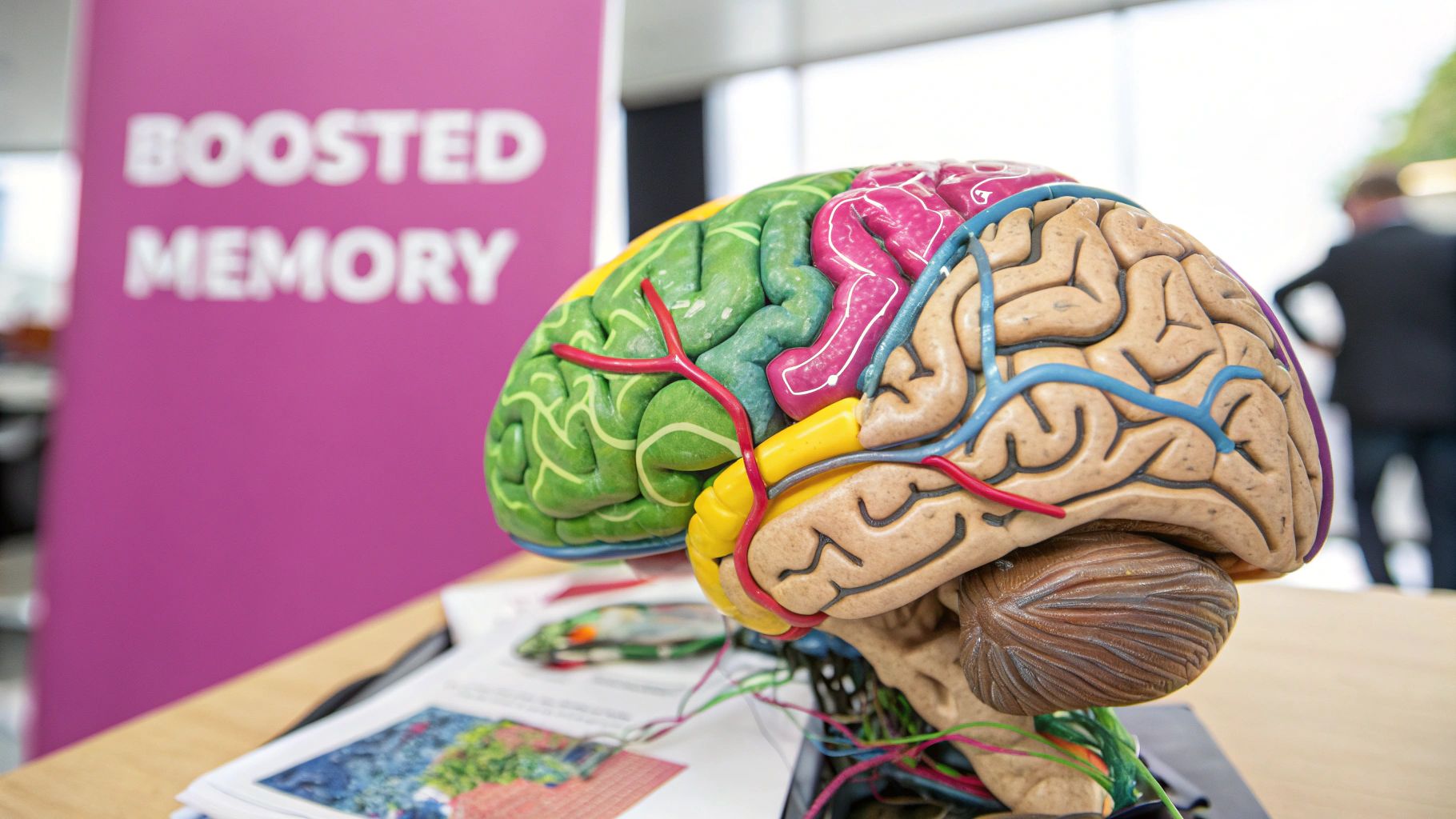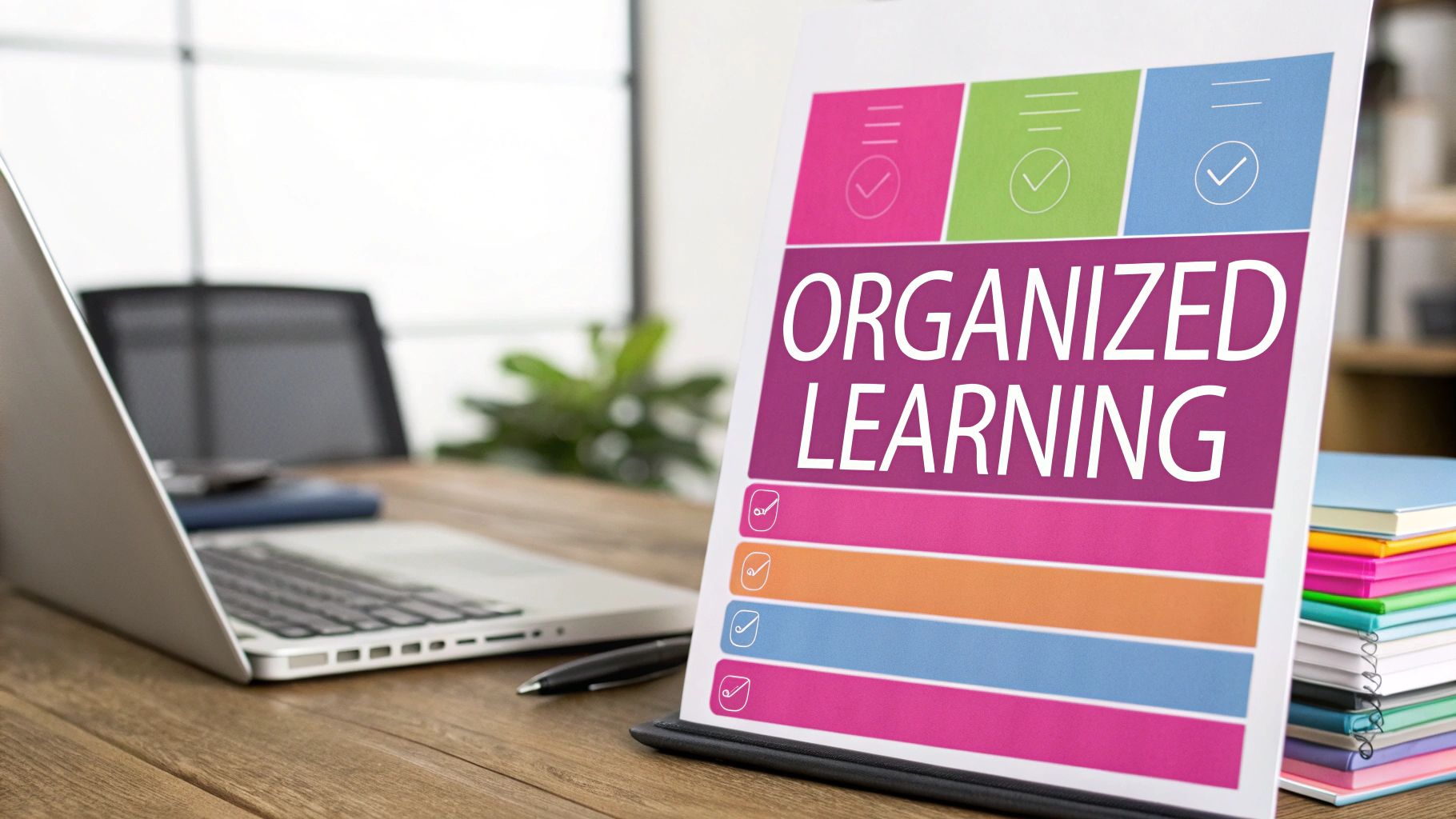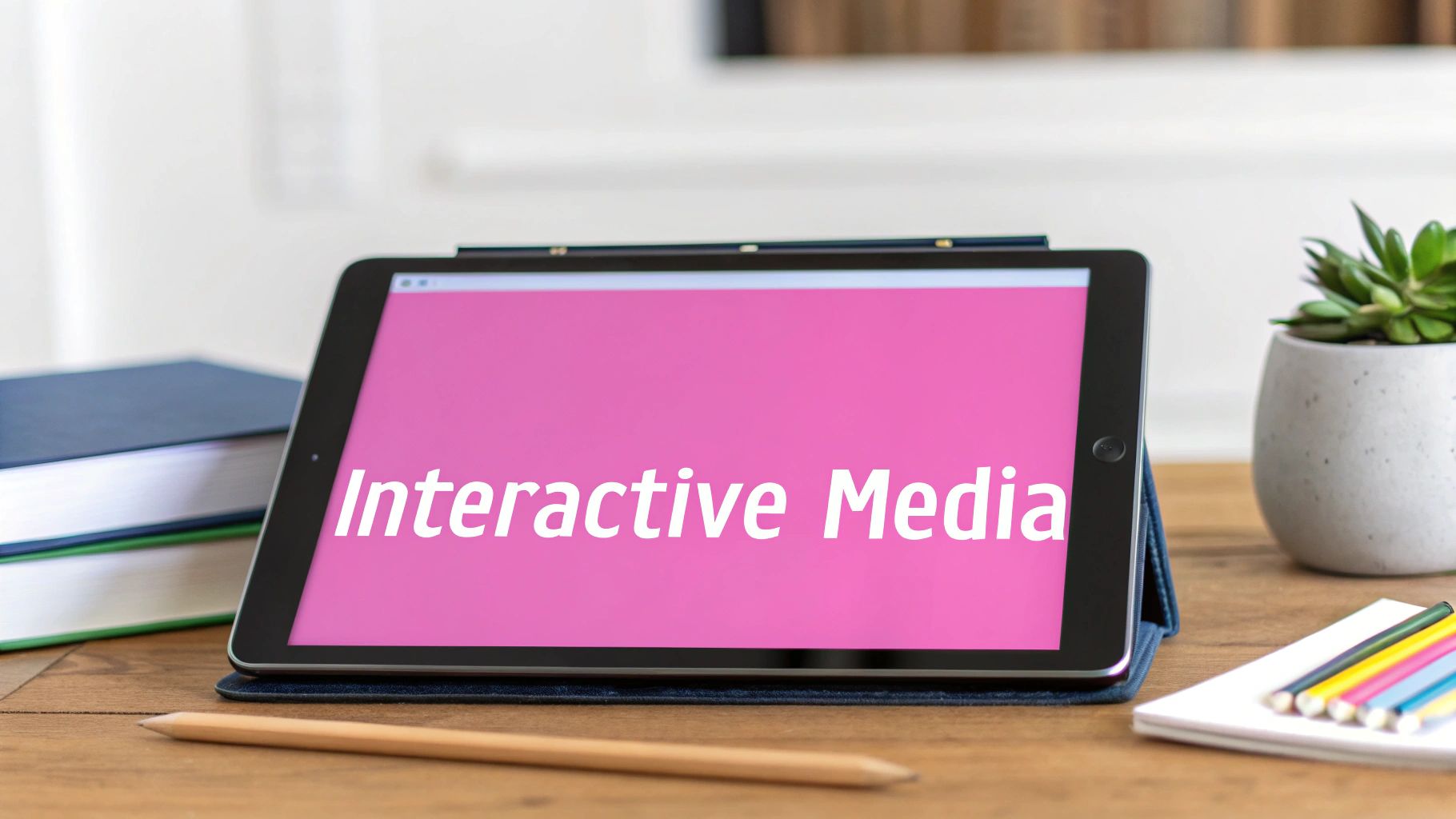
Visual Learning Benefits: Transform Your Learning Power Through Brain Science
Understanding Your Brain's Visual Superpower

The human brain dedicates over half its surface area to processing visual information, highlighting just how central vision is to how we understand and navigate the world. This remarkable ability allows us to process what we see in mere milliseconds – a capacity that profoundly shapes how we learn. Let's explore how this natural visual processing ability can help us learn and retain information more effectively.
Why We're Wired for Visuals
Our natural inclination toward visual learning stems from how our brains are built. Studies show that we process visual information an incredible 60,000 times faster than text. When we see an image or diagram, our brain quickly extracts meaning and understanding – often grasping complex ideas more readily than through words alone. For instance, a simple sketch can often communicate a complicated concept more clearly than several paragraphs of explanation. This innate efficiency makes visual learning particularly powerful.
The Impact of Visual Processing on Learning
The speed of visual processing directly affects how well we learn and remember information. Consider how easily you can recall a friend's face or picture the layout of your home – these memories stick because they're rooted in visual experiences. When we learn using visual aids, our brains process and store the information more effectively. Research backs this up: people typically remember 65% of visually presented information after three days, compared to only 10-20% of written or spoken content. This striking difference shows just how much visual learning can boost retention.
Visual Learning: More Than Just Pictures
Effective visual learning involves thoughtfully choosing the right visual format for different types of information. Diagrams help clarify relationships between ideas, while charts make data trends easy to spot, and videos bring abstract concepts to life. Think about trying to understand complex statistics – a spreadsheet full of numbers can feel overwhelming, but that same data shown in a well-designed infographic suddenly becomes clear and meaningful. This ability to break down complex ideas into visual elements can improve understanding by up to 400%. By using visual learning strategically, we can work with our brain's natural strengths to absorb and retain information more effectively.
Breaking Through Memory Barriers With Visual Tools

Think about the last time you tried to remember information from a textbook versus a diagram. Chances are, the visual elements stuck with you much longer than the text. This is no coincidence – research shows that while we typically retain only 10-20% of written or spoken information after three days, our retention of visual information reaches an impressive 65%. The stark difference shows just how effectively visual learning can cement information in our minds.
Why Visuals Enhance Memory
Our brains are wired to process visual information incredibly efficiently. Over half of our brain's surface area focuses on processing visual input, and we can process images 60,000 times faster than text. This means visual information takes a more direct route into our long-term memory compared to text. For example, when studying cell biology, a labeled diagram helps students grasp and remember the parts much more effectively than a written list. The visual format provides natural context and shows relationships between components, making the information more meaningful and memorable.
Transforming Abstract Concepts into Visual Experiences
Visual learning does more than just help us memorize facts – it allows us to understand complex ideas that would be hard to grasp through words alone. By giving concrete form to abstract concepts, visuals make challenging topics more approachable. For instance, understanding gravity becomes much clearer through a simple animation of a falling apple compared to a lengthy written explanation.
Practical Applications of Visual Learning
We can apply visual learning techniques in many practical ways to improve how we learn and remember information:
- Mind Maps: Create visual networks showing connections between ideas instead of linear notes. This works especially well for organizing complex projects and brainstorming.
- Sketchnoting: Combine simple drawings, symbols, and key phrases to create engaging visual notes that activate both creative and analytical thinking.
- Infographics: Present data and statistics in visually appealing formats that are easy to understand and remember.
- Videos and Animations: Use motion and visuals to demonstrate processes and explain concepts clearly.
- Interactive Simulations: Learn through hands-on exploration of concepts in dynamic environments.
Digital tools can make visual learning even more effective. Notescast, for instance, helps transform written materials into engaging video content, turning routine study sessions into interactive visual experiences. By incorporating these visual techniques and tools into our learning process, we can overcome memory limitations and learn more effectively.
Making Complex Ideas Crystal Clear

Visual learning does more than help us remember facts – it gives us the power to understand difficult concepts that would be hard to grasp through text alone. Let's explore how turning complex information into clear visuals makes learning both easier and more effective.
Choosing the Right Visual Format
Success with visual learning starts with picking the best format for each type of information. For instance, timelines work perfectly for showing how events unfolded over history, while Venn diagrams clearly show how different ideas overlap and connect. Process flows break complicated procedures into clear, easy-to-follow steps. By matching the right visual tool to each learning need, we can help different types of learners grasp new concepts more easily.
Identifying Visual Patterns for Deeper Understanding
One of the biggest advantages of visual learning is how it reveals patterns that might stay hidden in text. When we look at a sales graph, we can instantly spot trends, peaks, and dips that would take much longer to find in a spreadsheet of numbers. Good infographics take this even further by blending charts, icons, and brief text to tell a complete story at a glance. These visual elements work together to help us see connections and make sense of complex information.
Deconstructing Complexity into Digestible Visual Elements
Visual learning excels at breaking down complicated topics into smaller, easier-to-understand pieces. Consider learning about how blood flows through the body – a detailed diagram with labeled parts and color-coding makes this complex system much clearer than paragraphs of text trying to explain the same thing. By dividing big concepts into visual chunks, we make challenging material more approachable and memorable.
Real-World Applications and Success Stories
We see visual learning making a real difference across many settings. Teachers use interactive displays and video content to keep students engaged and help them learn better. Business presentations rely on visual aids to explain data and plans clearly to teams. This widespread use of visuals isn't just a trend – studies show that visual learning can improve understanding by up to 400%. These results prove just how powerful visual tools can be for helping people learn and retain new information.
Unlocking The Power of Color Psychology

Color plays a vital role in how we learn and process information visually. Beyond just making things look appealing, color directly affects our ability to understand and remember what we see. Let's explore how strategic color choices can enhance the learning experience and improve knowledge retention.
How Color Impacts Memory and Processing Speed
Research shows that color has a powerful effect on how our brains work. Adding color to learning materials can boost memory retention by up to 39%. For instance, when you highlight key terms in different colors or use colored sections in diagrams, learners remember the information much better compared to plain black and white materials. Color also helps us process information up to 80% faster. Think about reading a long document – when headings and important points are color-coded, you can quickly scan and understand the content. This is particularly helpful for people who learn best through visual means.
Practical Applications of Color in Learning
Different colors trigger distinct responses in our brains, which we can use to our advantage when creating learning materials. Red and orange, being warm colors, grab attention and create urgency – perfect for highlighting crucial information. However, use them sparingly to avoid overwhelming learners. Blue and green have a calming effect that helps maintain focus, making them excellent choices for backgrounds and main text areas where sustained attention is needed.
Here are some proven color combinations for learning materials:
- Blue and Yellow: These colors create strong contrast that makes text easy to read, especially in presentations and visual aids.
- Green and White: The soothing green paired with clean white space creates an ideal environment for focused learning.
- Orange and White: Using orange to highlight key points against white helps important information stand out and stick in memory.
Examples of Effective Color Use in Visual Learning
We can see color psychology at work in many successful learning environments. Educational websites often use bright colors strategically to maintain student engagement. Many business training programs use color coding to help employees navigate through different topics. The everyday example of traffic lights shows how deeply ingrained color associations can be – we instantly understand that red means stop and green means go. By applying these same principles to learning materials, we can help learners process and retain information more effectively. Tools like Notescast demonstrate how thoughtful color use in video learning can create more engaging and memorable educational content.
Making Digital Tools Work for Visual Learning
Digital tools open up exciting new possibilities for visual learning when used effectively. Rather than being optional add-ons, these tools can meaningfully strengthen how students process and retain information through visual means. When implemented thoughtfully, digital resources allow students to interact with content in engaging ways that lead to better understanding.
Digital Tools That Support Visual Learning
Students have access to many digital tools that can enhance visual learning in different ways. Here are some key categories and how they help:
-
Interactive Simulations: These give students hands-on ways to explore complex ideas. For instance, when studying astronomy, students can manipulate 3D models of planets to see their orbits and relative sizes firsthand. This direct interaction helps cement understanding.
-
Video Learning Platforms: Services like YouTube, Khan Academy, and Notescast offer rich visual content through animations and recorded lessons. Notescast specifically helps turn written materials into engaging videos, making reading more active and visual.
-
Mind Mapping Software: Programs like XMind and MindManager help students create visual diagrams showing how ideas connect. This improves organization and understanding of relationships between concepts.
-
Augmented and Virtual Reality: These immersive technologies create powerful visual learning experiences. Medical students can explore 3D anatomy through VR, while history students can use AR to step into historical events. This brings abstract topics to life.
-
Interactive Whiteboards and Presentations: These tools add visual elements to teaching through images, videos, and interactive activities. This keeps students engaged and encourages participation.
Selecting Digital Tools Wisely
With so many options available, it's important to choose digital tools carefully based on your specific needs. Consider these key factors:
| Criteria | Description |
|---|---|
| Learning Objective: | What specific skills or knowledge do you aim to acquire? |
| Learning Style: | Which visual formats resonate most effectively with your learning preferences? |
| Accessibility: | Is the tool user-friendly and compatible with your devices? |
| Cost-Effectiveness: | Does the tool offer sufficient value for its price? |
| Integration: | Does it seamlessly integrate with existing learning management systems or other tools? |
Working Through Common Challenges
While digital tools offer clear benefits for visual learning, some practical hurdles often come up:
-
Technical Issues: Problems with internet connections, software glitches, or unfamiliarity with tools can interrupt learning.
-
Cost Limitations: Some tools require paid subscriptions or expensive equipment, which may not fit all budgets.
-
Training Needs: Both teachers and students often need guidance to use digital tools effectively.
-
Content Management: The sheer amount of available digital content can make it hard to find quality materials.
Schools can address these challenges through careful planning and support. For example, providing teacher training ensures they can effectively incorporate digital tools into lessons. Similarly, giving students tutorials helps them use new technologies confidently. With thoughtful implementation, digital tools can significantly improve how students learn through visual means.
Putting Visual Learning Into Practice
Learning through visuals is proven to boost retention and understanding, but how do we effectively apply these principles in real life? This section breaks down practical ways to use visual elements for better learning outcomes, moving beyond simply adding images to creating truly effective visual learning experiences.
Strategies for Creating Effective Visual Learning Materials
Creating impactful visual materials requires thoughtful planning. Here are key techniques you can start using today:
-
Choose the Right Visual Format: Match your content with the most suitable visual format. Use timelines to show progression of events, mind maps for brainstorming sessions, and infographics when you need to present data clearly. Each format serves a specific purpose for maximum impact.
-
Use Color Purposefully: Studies show color can boost memory retention by 39%. Apply colors strategically – use blue tones to promote focus and red for highlighting important points. The key is using color with intent rather than just for decoration.
-
Keep It Clean and Simple: Avoid overwhelming your materials with too many visual elements. Focus on essential information and embrace white space to help learners concentrate on what matters most. Remember – sometimes less really is more.
-
Add Interactive Elements: Turn passive viewing into active learning by incorporating quizzes, clickable diagrams, and hands-on activities. This engagement helps cement learning and makes the experience more memorable and effective.
Measuring Learning Outcomes
To ensure visual learning methods are working, we need to track progress systematically. Here are proven ways to measure effectiveness:
-
Pre- and Post-Tests: Compare knowledge levels before and after using visual materials. This provides concrete data about how well the visuals helped with learning.
-
Recall Activities: Have learners demonstrate understanding by creating their own visual summaries or explaining concepts using diagrams. This shows how well they've internalized the information.
-
Watch and Listen: Pay attention to how people interact with visual materials. Are they engaged? Asking questions? Get direct feedback about what works and what needs improvement.
Overcoming Implementation Challenges
Adding visual elements to learning can present some hurdles. Here are common challenges and practical solutions:
-
Time Management: Creating visuals takes time. Save effort by using ready-made templates and tools designed for quick visual content creation.
-
Tech Access: Limited software access shouldn't stop you. Start with basic visual techniques and explore free tools that can help create simple but effective materials.
-
Getting Buy-In: Some may resist new learning methods. Start small, share success stories, and demonstrate real results to build confidence in visual learning approaches.
Making your learning more visual doesn't have to be complicated. By applying these practical strategies and using tools like Notescast, you can significantly improve how you learn and retain information. Notescast makes it simple to transform your notes into engaging video content, helping make learning more interactive and memorable. Ready to enhance your learning experience? Check out Notescast now!
